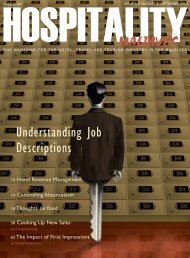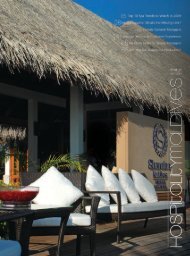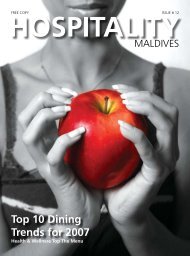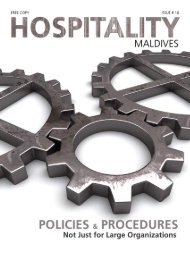Don't Let Your Systems Drive Your Customers Crazy! - Hospitality ...
Don't Let Your Systems Drive Your Customers Crazy! - Hospitality ...
Don't Let Your Systems Drive Your Customers Crazy! - Hospitality ...
Create successful ePaper yourself
Turn your PDF publications into a flip-book with our unique Google optimized e-Paper software.
FOOD & BEVERAGE<br />
The Food Cost Percentage - Decomposed<br />
Too much attention is placed on inventory accuracy. Most<br />
people miss the finer points of determining their food<br />
cost percentage. Clearly, the sales figure which dominates<br />
the formula should take center stage. A very close second is the<br />
purchases figure. The inventory obsessed need to take a different<br />
view.<br />
Many hotels and restaurants count monthly (or every four<br />
weeks) and I see too much emphasis on inventory valuation. The<br />
impact of inventory change depends on the time period. Monthly<br />
values should be reasonable given the day of week and time of<br />
year. The change in the inventory value (i.e. beginning minus ending)<br />
hardly matters once a period of 90 days is considered.<br />
Inventory is very important in a weekly analysis and all important<br />
in a daily calculation. If you’re researching a problem and<br />
perform daily calculations you need to be very exact.<br />
The wonderful POS systems available today from the best<br />
companies provide a bundle of sales analysis. My favorites are<br />
check average and covers by meal period. I break down sales using<br />
a simple matrix with a row for each meal period and columns<br />
for covers, check average and sales.<br />
On the purchases side, I break down the purchase data using<br />
a larger matrix with rows for each key item and grouped data for<br />
low impact items by category. The columns include units, average<br />
cost and total cost.<br />
For the inventory, I prefer a simple inventory change figure.<br />
One number is fine. Simply subtract the current period’s value<br />
from the previous period’s value. The net value should be a reasonable<br />
and consistent estimate. Don’t count WIP inventory one<br />
period and eliminate the figure the next period.<br />
Some quick checks on inventory value by location and category<br />
will provide enough information to locate the flour extended<br />
by case price when the count team used pounds. Perform a<br />
simple analytical review and correct major errors.<br />
by Joe Dunbar<br />
Many operators give no credit for highly perishable items like<br />
bread, fresh fish and other items specific to the operation. This<br />
helps to avoid over buying since the items are expensed immediately.<br />
Inventory valuation should not be the reason for a good<br />
or bad food cost percentage in any given period. Any operation<br />
which runs a hi-low pattern or a low-low-hi pattern has a<br />
far greater problem. These patterns typically point out cost control<br />
weaknesses. Someone is trying to hide the truth. I have seen<br />
plenty of inventory extensions with a spice valued at $1,000 plus.<br />
The people presenting these reports may be both incompetent<br />
and dishonest.<br />
“ The net value should be a<br />
reasonable…”<br />
Look long and hard at sales trends by meal period. Some operations<br />
run lunch menus with higher implicit costs. If the lunch/<br />
dinner ratio changes, the food cost will be impacted. Extremely<br />
high or low counts will have a major impact as well.<br />
Most of the real action will be in purchases since the money<br />
you spend with your suppliers is your cost. Highlight dramatic<br />
price changes on any key item. Look for flaws in your ordering<br />
strategy. Compare figures from one period to the next and over<br />
the long term.<br />
If you focus on sales and purchases, food cost percentage<br />
surprises will be fewer and more positive.<br />
Joe Dunbar Dunbar Associates 11350 Random Hills Road Suite 800 Fairfax,<br />
VA 22030 800-949-3295 jdunbar401@aol.com http://foodcostcontrol.blogspot.<br />
com<br />
HOSPITALITY MALDIVES OCTOBER/NOVEMBER 2006 27

















